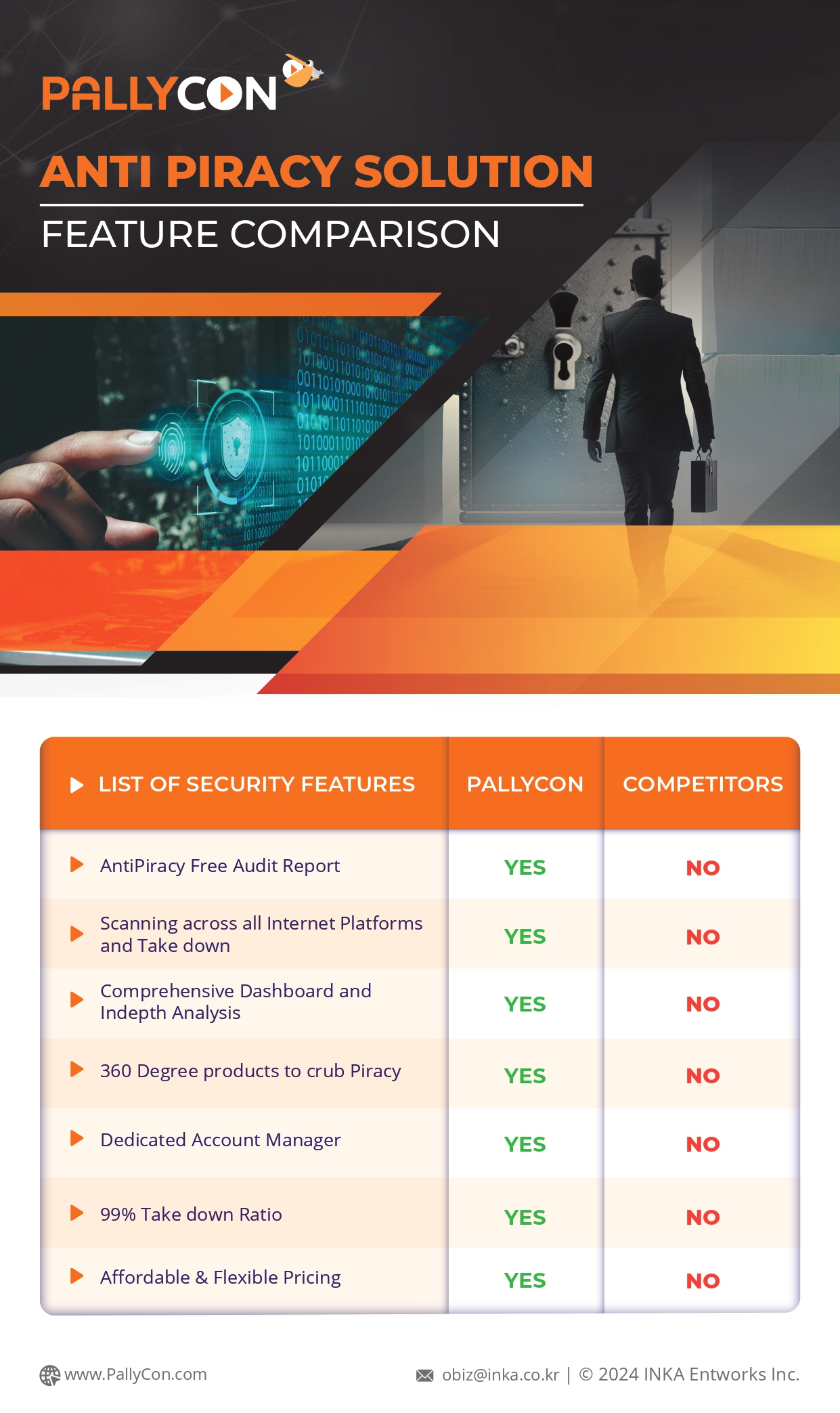
10 Effective Anti-piracy Measures for Businesses to Secure Content
Content has always been an incredibly valuable asset for creators, distributors, and even businesses. However, today, the value of content has increased significantly due to digitalisation, and so has the increase in piracy threats. Whether it is movies, music, e-books, video games, or even software, the threat of piracy is prominent.
Global visits to piracy websites reached more than 215 billion in 2024, marking an 18% increase from the previous year. Pirated video content receives over 230 billion views annually, with illegal streaming services contributing to more than 80% of online piracy.
Streaming platforms are the largest source of pirated content at 63%, followed by mobile apps at 16%. Video content piracy is estimated to cost the global media sector approximately $75 billion annually.
In the case of businesses, the danger is far greater than the lost revenue, as piracy hinders innovation and damages consumer trust. So, the need to educate oneself against anti-piracy measures is necessary to combat this issue in future.
In this article, we delve into the most effective anti-piracy measures. We also talk about the necessity of a comprehensive and multi-layered approach to protect digital content.
1. Digital Rights Management (DRM) Solutions
Digital rights management (DRM) is an essential and modern anti-piracy measure. The primary motive of this anti-piracy measure is to safeguard digital content from unauthorised access and distribution. This anti-piracy measure further manages how content is accessed and shared. Pallycon’s Multi DRM services are one of the best anti-piracy measures, securely encrypting digital content and allowing only authorised users to access it.
Content Encryption :
This is a way of putting a digital lock on the content. Only those who have the right key can unlock it and view it. PallyCon’s multi-DRM technology supports major systems like PlayReady, Widevine, and FairPlay, which helps content creators protect their media on different platforms like Smart TVs, smartphones, tablets, and computers.
License Control :
With DRM solutions, companies can set rules for using their content. For example, a time-bound license (like a movie rental that expires after a few days) or other conditions, such as limiting content to be played on certain devices, can help companies prevent unauthorized copying or sharing.
Watermarking Integration :
As a part of anti-piracy measures, DRM often includes invisible marks called watermarks, which are unique user information embedded into the content. If the content leaks or is distributed without permission, these watermarks can help trace it back to the original source and help identify who accessed it initially.
2. Forensic Watermarking
While DRM ensures control over who can view or use the content, forensic watermarking adds another layer of traceability to detect the source from where it was distributed unauthorised. This anti-piracy measure is a technique that embeds unique, invisible, and secure markers or identifiers into digital content, such as videos, images, audio, or documents. Here’s how forensic watermarking acts as an anti-piracy measure.
Unique Identifiers :
Forensic watermarking embeds invisible, unique identifiers directly into digital content. This makes each copy distinct and traceable back to individual users or the particular distribution points. If a copy is found circulating without permission, the embedded watermark helps track down the source responsible for the leak.
Dynamic Watermarking :
Some advanced watermarking technologies use dynamic data, meaning the watermark information changes during playback. This makes it harder for potential pirates to remove or alter the watermark without compromising the content’s quality. PallyCon’s DRM solutions integrate such watermarking capabilities to enhance protection.
Deterrent Effect :
This knowledge that content includes invisible and traceable watermarks can stop potential pirates from distribution. Knowing that they can be identified and can be tracked down easily discourages pirates from any such acts and reduces the likelihood of piracy.
This combination of DRM and forensic watermarking is a powerful anti-piracy measure for content creators, enhancing the security of their digital assets.
3. Tokenized Access and User Authentication
This robust anti-piracy measure controls access to only authorised users, which is necessary to maintain security and prevent unauthorised use of any content. Two key strategies that help strengthen access control are token-based authentication and multi-factor authentication.
Token-Based Authentication :
In this method, each user is provided with a unique, time-limited token for their session.
Session Tokens :
When an authorised user logs in or tries to access protected content, they receive a token. This token is like a digital key that is valid only for a short time or for a session. As these tokens expire after a session, it becomes much harder for unauthorized users to share them after the validity period. This type of authentication helps limit content sharing and ensure tight content control.
Single-Use Tokens :
Single-use tokens add an extra layer of security because they work only once and then become invalid. For example, if someone tries to reuse an expired token, they won’t be able to access the content. This approach effectively prevents the token from being shared multiple times.
Multi-Factor Authentication :
MFA adds an extra layer of security as it requires more than just a username and password. After entering your usual login details, you may need to enter an OTP sent to your phone or scan your fingerprint. This means that even if your account login details have been hacked, they will not be able to get access to the account as they have to provide another verification. This anti-piracy measure reduces the risk of account takeovers and adds a strong barrier that makes it more difficult for unauthorised users to bypass security.
4. Content Delivery Network (CDN) Security
A Content Delivery Network (CDN) is a secure way to quickly and safely deliver digital content like videos and images to users. This anti-piracy measure ensures that unauthorised users don’t intercept or access the content during transfer.
CDNs use encryption to protect data as it travels from the server to the user, thereby preventing hackers from stealing the content. They also create special links that only authorised users can use to access the content.
With the help of Geo Blocking CDNs can block or allow access based on a user’s location. This way content can be restricted in regions where piracy is common, thus preventing illegal streaming or downloads.
CDNs often use tokens to verify user access. This stops people who shouldn’t have access from viewing or downloading the material.
These measures make CDNs essential to protecting digital content from piracy and unauthorized use.
5. Automated Web Crawling and Takedown Services
Protecting digital content from being illegally shared online is a continuous task. To help with the monitoring automated web-crawling tools search for pirated content across the Internet, making it easier to take them down. As part of anti-piracy measure, these smart programs use advanced technology to look for unauthorised copies of content on various websites, streaming services, or torrent links. They can very quickly and accurately look for pirated content.
Once pirated content is found, companies can send legal requests called DMCA takedown notices. These notices tell the website owner to remove the content as soon as possible, stopping it from spreading further.
These tools are vital for monitoring the internet and acting fast to remove illegal content, thereby helping protect intellectual property.
6. Machine Learning and Artificial Intelligence (AI)
Today, AI and machine learning are playing a vital role in protecting digital content and are effective anti-piracy measures.
The predictive analysis feature of AI systems can examine large amounts of user data to identify patterns in behaviour. If certain actions seem unusual or hint at misuse, for example, if someone tries to download content that they shouldn’t, the AI flags this as suspicious. This way, potential problems can be spotted and dealt with before they become serious.
Also, pirates are constantly changing their tactics to circumvent security. Here, Machine learning helps, as the algorithms don’t just follow a set of rules; they learn and improve as they encounter new challenges. This means they can adapt to new piracy methods over time, keeping protection measures one step ahead and more effective.
7. User Education and Awareness
Educating people about the various anti-piracy measures and the negative effects of piracy can be a powerful way to reduce it. When users understand how piracy harms creators and businesses, the chances of piracy can be reduced significantly. Companies can run educational campaigns that highlight why piracy is damaging, both ethically and legally. These campaigns can explain that piracy reduces revenue for content creators, which in turn affects the quality and availability of new content.
Additionally, as part of anti-piracy measures, in-app notifications can include friendly reminders to inform users about how piracy impacts everyone involved in creating content. These notifications don’t disrupt the user experience but reinforce the idea that choosing legal options supports the industry and creators.
8. Secure Application Development
Ensuring the security of apps and platforms that distribute content is very important. If the software has vulnerabilities, pirates can exploit them, leading to unauthorised access or content theft.
Code Obfuscation is a technique that scrambles and disguises code, making it much harder for attackers to understand. By doing this, it becomes more difficult for pirates to find and exploit weak points or bypass security measures.
Additionally, conducting regular security checks helps find and fix issues before they can be used by attackers. Frequent audits ensure that any potential vulnerabilities are identified and corrected, keeping the digital platform safe and reliable.
9. Blockchain Technology
Blockchain technology can be an effective anti-piracy measure for protecting digital assets. It is a secure tool for recording and storing digital information that is transparent, immutable and transfer-proof. Its structure is decentralised, meaning data is stored across multiple systems, making unauthorised access or tampering more difficult. Using blockchain can add a strong layer of security to digital content, making it transparent and safer from piracy.
10. Frequent Updates and Patching
Ensuring that content distribution platforms and applications are kept up-to-date is key to closing security gaps. Hackers often take advantage of outdated systems to bypass protection. Using automated updates ensures that important security patches are applied promptly, and there is a reduced risk of vulnerabilities and exploitation by attackers.
Also, conducting thorough beta testing before launching helps identify and fix security issues, making the platform more secure for public use. Always have a multi-layered approach, as no single tool or method is foolproof against piracy.
Conclusion
Although the battle against piracy is ongoing, with a combination of advanced technology and anti-piracy measures, businesses can safeguard their digital content. Comprehensive solutions offered by companies like Pallycon can help businesses secure their content. Also, adopting a multi-faceted approach and utilising cutting-edge tools like AI and blockchain, along with awareness among users, create a protective environment that not only secures assets but also supports innovation and growth.
FAQs on Anti-piracy Measures
Are there legal penalties for using pirated software or content?
Yes, using pirated software or content can result in fines, legal action, or even criminal charges, depending on the infringement’s jurisdiction and severity.
How can consumers ensure they are accessing legitimate content?
To stay on the right side of the law, consumers should always use authorized platforms, verify the authenticity of the source, and avoid downloading content from suspicious websites.
What are some common signs of pirated content?
Pirated content often comes from unofficial sources, may have poor quality, lack customer support, or include suspicious ads and malware. Always check for licensing and trusted platforms.
What steps can organizations take to educate employees about anti-piracy?
Organizations can conduct training sessions, implement clear intellectual property policies, and issue regular reminders to emphasize the importance of using only licensed software and content.

Harish Bhat is a Forensic watermark Product Manager at PallyCon and has been associated with media and broadcasting industry for over 13 years. Apart from technical writing, an avid reader of latest trends in the streaming world and content protection.
